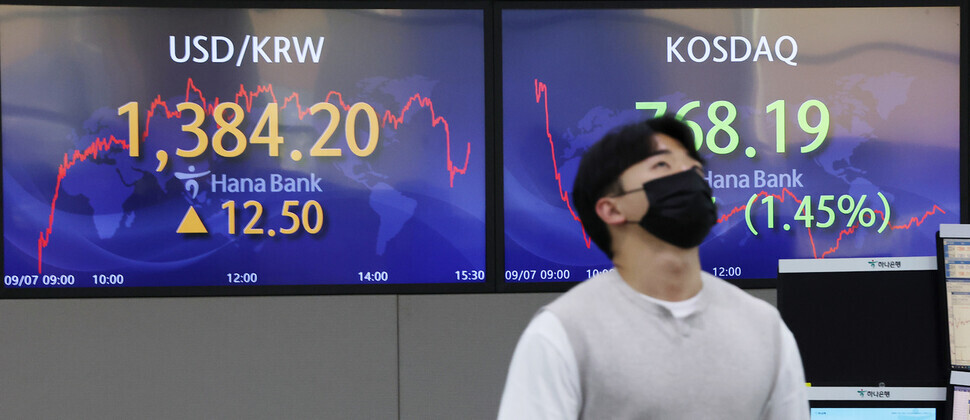hankyoreh
Links to other country sites 다른 나라 사이트 링크
Trade deficit, faltering chip business add to Korean won’s downward spiral

The won-to-dollar exchange rate passed 1,388.40 during trading Wednesday, leading many to predict it is only a matter of time before it crosses the 1,400 mark.
With no external variables likely to bring down the extreme strength of the US dollar globally, Korea is facing a number of factors that threaten to bring down the value of its currency further, including a deficit in its goods balance, worsening semiconductor exports, and outflows of funds from overseas investors. Some observers are stressing the need to prepare for the won to remain weak for some time to come.
In external terms, the won-to-dollar rate’s movement above 1,380 on Wednesday came at a time when there are no factors in the way of the dollar’s global strength. Domestically, the July goods balance deficit of US$1.18 billion that was announced the same day was one more factor bringing down the won’s value.
The goods and trade balances have been recording deficits amid steep increases in raw material prices. This has translated in turn into concerns about the domestic dollar supply.
Despite five straight months of negative figures for the balance of trade, which is calculated based on items passing through customs, the goods balance had previously been holding up in positive figures thanks to net positive exports in terms of transit trade — namely production and export activity by South Korean companies’ overseas branches.
But that changed in July, when imports increased by US$4.3 billion compared with the month before while transit trade net exports dropped by US$460 million into negative figures.
The number of factors weakening the won has been mounting over time.
“We can’t rule out the possibility of the won-to-dollar exchange rate rising further and reaching a new high in the 1,450–1,500 range,” predicted Park Sang-hyeon, an analyst at Hi Investment & Securities, on Wednesday.
Experts are also warning of trouble brewing for conditions in the semiconductors industry, which drives exports for the South Korean economy.
“The steep dive in the information and communications technology industry cycle is a new factor weakening the won,” Park said.
“We’re starting to see wobbling in semiconductor exports to China and Hong Kong, which rank first and third [as markets] for domestic semiconductor exports,” he explained.
Analysts are also predicting the US’ Inflation Reduction Act will negatively affect the won’s strength in the intermediate to long term. In other words, the drop in the won’s value could deepen due to the loss of funds and increased demand for dollar-denominated investment funds as South Korean companies increase their investment in local US production in order to take advantage of tax benefits.
“South Korean companies are inevitably going to continue investing overseas with the act in effect, and the loss of direct investment funds is another factor weakening the won,” Eugene Investment & Securities said Tuesday.
By Jun Seul-gi, staff reporter
Please direct questions or comments to [english@hani.co.kr]

Editorial・opinion
![[Editorial] Yoon must halt procurement of SM-3 interceptor missiles [Editorial] Yoon must halt procurement of SM-3 interceptor missiles](https://flexible.img.hani.co.kr/flexible/normal/500/300/imgdb/child/2024/0501/17145495551605_1717145495195344.jpg) [Editorial] Yoon must halt procurement of SM-3 interceptor missiles
[Editorial] Yoon must halt procurement of SM-3 interceptor missiles![[Guest essay] Maybe Korea’s rapid population decline is an opportunity, not a crisis [Guest essay] Maybe Korea’s rapid population decline is an opportunity, not a crisis](https://flexible.img.hani.co.kr/flexible/normal/500/300/imgdb/original/2024/0430/9417144634983596.jpg) [Guest essay] Maybe Korea’s rapid population decline is an opportunity, not a crisis
[Guest essay] Maybe Korea’s rapid population decline is an opportunity, not a crisis- [Column] Can Yoon steer diplomacy with Russia, China back on track?
- [Column] Season 2 of special prosecutor probe may be coming to Korea soon
- [Column] Park Geun-hye déjà vu in Yoon Suk-yeol
- [Editorial] New weight of N. Korea’s nuclear threats makes dialogue all the more urgent
- [Guest essay] The real reason Korea’s new right wants to dub Rhee a founding father
- [Column] ‘Choson’: Is it time we start referring to N. Korea in its own terms?
- [Editorial] Japan’s rewriting of history with Korea has gone too far
- [Column] The president’s questionable capacity for dialogue
Most viewed articles
- 1Months and months of overdue wages are pushing migrant workers in Korea into debt
- 2At heart of West’s handwringing over Chinese ‘overcapacity,’ a battle to lead key future industries
- 3[Editorial] Yoon must halt procurement of SM-3 interceptor missiles
- 4Fruitless Yoon-Lee summit inflames partisan tensions in Korea
- 5Trump asks why US would defend Korea, hints at hiking Seoul’s defense cost burden
- 6Dermatology, plastic surgery drove record medical tourism to Korea in 2023
- 71 in 3 S. Korean security experts support nuclear armament, CSIS finds
- 8[Editorial] New weight of N. Korea’s nuclear threats makes dialogue all the more urgent
- 9South Korea officially an aged society just 17 years after becoming aging society
- 10[Column] For K-pop idols, is all love forbidden love?